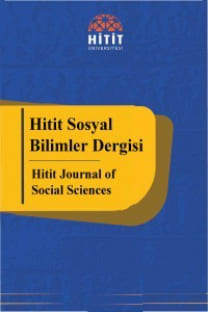THE “CRABS IN A BUCKET” MENTALITY IN HEALTHCARE PERSONNEL: A PHENOMENOLOGICAL STUDY
Yengeç zihniyeti, Fenomenolojik araştırma, Sağlık hizmeti, Yengeç sepeti sendromu, Sepetteki yengeçler
THE “CRABS IN A BUCKET” MENTALITY IN HEALTHCARE PERSONNEL: A PHENOMENOLOGICAL STUDY
Crab mentality, Phenomenologic research, Healthcare environment, Crab bucket syndrome, Crabs in a bucket,
___
- Abrugar, V. Q. (2014). 10 Signs that a Person has a Crab Mentality. Retrieved from: http://faq.ph/10-signs-thata-person-has-a-crab-mentality/.
- Brosky, D.J. (2009). Icropolitics In The School: Teacher Leaders' Use Of Political Skill And Influence Tactics, Doctor Of Philosophy In Education, Department of Educational Leadership Oakland University, Michigan.
- Bulloch, H.C.M. (2017). Ambivalent moralities of cooperation and corruption: Local explanations for (under) development on a Philippine island, The Australian Journal of Anthropology. 28: 56–71.
- Creswell, J.W. (2013). Nitel Araştırma Yöntemleri, Beş Yaklaşıma Göre Nitel Araştırma ve Araştırma Deseni, M., Bütün, S.B. Demir, (Eds.) 3rd ed. 69-110.
- Irmak, R. (2010). Cam Tavan Sendromu - Bir Hastane Uygulaması, Dokuz Eylül Üniversitesi Sosyal Bilimler Enstitüsü İşletme Anabilim Dalı Hastane Ve Sağlık Kuruluşları Yönetimi, Master's Thesis, İzmir.
- Krysik, J.L., Finn, J. (2015). Etkili Uygulama İçin Sosyal Hizmet Araştırması, E. Erbay, (Ed.). Nika Publishing, Ankara, 1st ed. 210-211.
- Miller, C.D. (2016). Interpersonal Competitive Dynamics In The Workplace: The Dark Side Of Demographic Similarity, The University Of Texas At Dallas, Doctor Of Philosophy In International Management Studies.
- Miller, C. D. (2014). The crabs in a barrel syndrome: Structural influence on competitive behavior. In Academy of Management proceedings. 1: 155-56.
- Mizrahi, R., Aracı, H. (2010). Kadın Yöneticiler Ve Cam Tavan Sendromu Üzerine Bir Araştırma, Organizasyon Ve Yönetim Bilimleri Dergisi. 2(1): 149-156.
- Perry, K. (2009). Kicking the Bucket: It’s All About Living, Educational Perspectives. 45(1-2): 7-16.
- Rajan, R.G. (2009). Rent Preservation and the Persistence of Underdevelopment, American Economic Journal: Macroeconomics. 1(1):178–218.
- Soubhari, T., Kumar, Y. (2014). The CRAB - Bucket Effect and Its Impact on Job Stress An Exploratory Study With Reference To Autonomous Colleges, International Journal on Recent and Innovation Trends in Computing and Communication. 2(10): 3022-3027.
- Spacey, S. (2015). Crab Mentality, Cyberbullying and “Name and Shame” Rankings. Retrieved from: https://pdfs.semanticscholar.org/3e43/a0f74b4111c41513f2e0d0a13c92e79efb18.pdf.
- Weller, J., Boyd, M., Cumin, D. (2014). Teams, tribes and patient safety: overcoming barriers to effective teamwork in healthcare, Postgrad Med J. 1–6.
- Yayın Aralığı: Yılda 2 Sayı
- Başlangıç: 2008
- Yayıncı: Hitit Üniversitesi
TARİHSEL SÜREÇLERİN KÜLTÜR VE TURİZM AÇISINDAN DEĞERLENDİRİLMESİ: ERTUĞRUL FIRKATEYNİ
SUSTAINABILITY REPORTING AND INTEGRATED REPORTING: EVIDENCE FROM TURKISH HIGH PERFORMANCE COMPANIES
Belverd E. NEEDLES JR., Emre Selçuk SARI, Nevzat GÜNGÖR, Ahmet TÜREL, Mustafa CAN
Mustafa KÖSEOĞLU, Hüseyin ÜNAL
PERAKENDECİLİKTE REKABET SİLAHI OLARAK PERAKENDECİ MARKASI VE ANKARA İLİNDE BİR UYGULAMA
NAKİT YÖNETİMİNİ ETKİLEYEN DEĞİŞKENLER ÜZERİNE BIST PERAKENDE SEKTÖRÜNDE PANEL VERİ ANALİZİ
TÜRKİYE’DE CARİ İŞLEMLER AÇIĞI: NEDENLER VE ÇÖZÜM ÖNERİLERİ
Hamiyet YİĞİT, Süleyman AÇIKALIN
THE “CRABS IN A BUCKET” MENTALITY IN HEALTHCARE PERSONNEL: A PHENOMENOLOGICAL STUDY
Gizem Zevde AYDIN, Gülpembe OĞUZHAN
TÜRKİYE’DE BÖLGESEL GELİR DENGESİZLİĞİ: İŞGÜCÜ BAŞINA GELİR YAKINSAMASI
